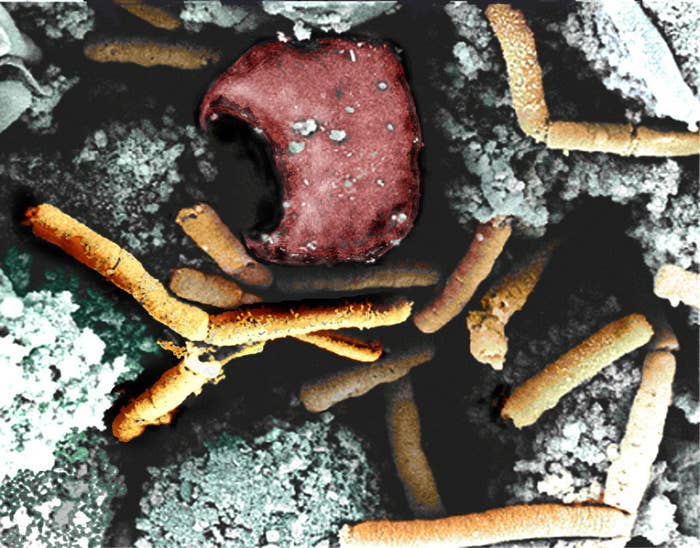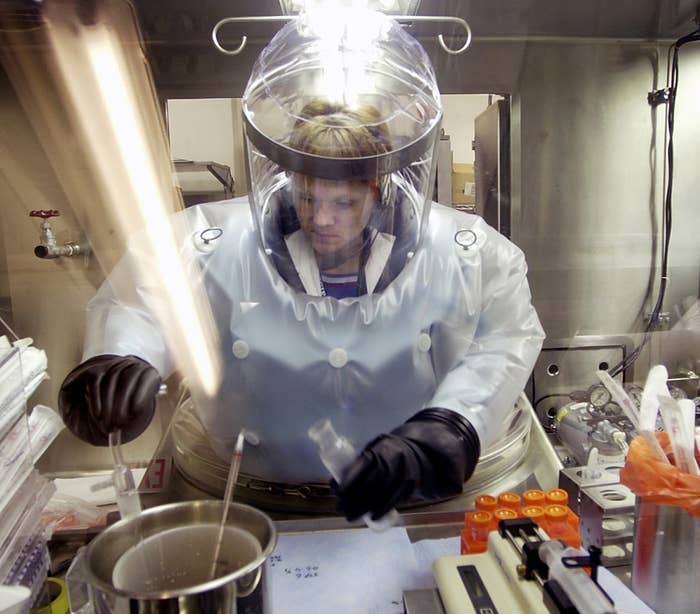
Anthrax is ridiculously hard to kill. If trapped in a dark vat of sea water, the deadly bacteria can still live 20 months. If deprived of water and exposed to nothing but dim daylight, it can germinate for 22 years. If buried deep underground, it can live for more than 70 years.
And, as was revealed last week, some of these hearty bugs can even survive 90 minutes of powerful radiation. Because of this radiation resilience, for years the U.S. Army's Dugway Proving Grounds in Utah has inadvertently shipped live anthrax spores to more than two dozen labs in the U.S., Australia, and South Korea.
Federal investigators are now reviewing Defense Department lab procedures to figure out a more reliable way to kill this nearly unkillable bug, microbiologists told BuzzFeed News.
"That's why it's such a terrible weapon. It tends to hang around," Kenneth Berns, a biochemist at the University of Florida and head of the American Society for Microbiology's biodefense committee, told BuzzFeed News. "Fundamentally, anthrax is a very difficult bacteria to inactivate."
On Sunday, Defense Secretary Ashton Carter promised to hold personnel at Dugway "accountable" for the shipments of viable anthrax. So far, no one has been infected, and two dozen people who worked at the labs that received the samples are taking antibiotics as a precaution.
Though these recent incidents don't present a risk to the public, authorities are on high alert. Inhaling dried anthrax spores can lead to a deadly lung infection in about a week if not treated quickly. In 2001, five people died after receiving letters filled with dried anthrax in the mail. The bioterror attack briefly paralyzed the U.S. Postal Service and shut down the U.S. House and Senate offices.
"It's very serious to ship living anthrax under conditions where you have stated it's inactive," Berns said. "What's distressing is that government labs should be models for handling anthrax."
The Dugway spores were treated with gamma radiation, the most penetrating kind of radioactivity, to inactivate the anthrax spores, according to Army Chief of Staff Ray Odierno. Last Friday, Odierno blamed a mechanical failure, rather than human error, for the anthrax still being alive when shipped.
Berns says that's not good enough: "Clearly somebody did not check that the anthrax was inactive."

The secret to anthrax’s survival is the tough coat that surrounds its dry spores.
"If you want a perfect package for protecting DNA, that's it," Thomas Coohill, a health physicist at Siena College in Londonville, New York, told BuzzFeed News.
In particular, he added, the crystalline coating of anthrax spores has evolved to be resistant to the damaging effects of the sun's UV rays, which partly explains the bug's tenacity in the face of radiation. "In its spore state, it is about 50 times more robust than normal bacteria," Coohill said.
In nature, anthrax survives in the soil in spore form, typically waiting for a cow or goat to graze on contaminated vegetation, triggering an infection that kills the animal. When the animal dies, more spores end up in the ground, waiting for the day when another animal consumes them. The spores have to survive digestion, burial, exposure to sunlight, and years of dormancy to complete their life cycle.
The labs in the ongoing investigation received their anthrax samples by mail, shipped by FedEx from Dugway, as part of biodefense efforts to test rapid detection methods. Radiation is an attractive way to kill spores while leaving them intact enough to test detection assays, a hot area of research in biodefense circles. Ideally, the anthrax samples should have received about 90 minutes of gamma radiation, according to a 2009 Centers for Disease Control and Prevention study, to kill them.
"The trouble is that the process of inactivation is not perfect and biology has made anthrax very resistant," John Clements, a vaccine researcher at Tulane University in New Orleans, told BuzzFeed News. "Life finds a way. Someone turns the stove off one minute too early, and some spores aren't completely inactivated."
When it comes to radiation, anthrax samples stuffed with too many spores or containing too much water might survive inactivation attempts, the 2009 study warned, making mismeasurement a possible culprit in the case.
The spores are so resistant to radiation that scientists have actually suggested that bacteria closely related to anthrax might survive for 600,000 years under the soil of Mars. That's one reason why NASA engineers carefully sterilize spacecraft before they head to the Red Planet.
That's also why labs are supposed to check even "inactive" anthrax samples for viability by trying to grow them in petri dishes as soon as they have been opened, Clements said. One of the receiving labs in Maryland alerted both the Army and the CDC to the problem after doing just that, in fact, triggering the current investigation.
"In a sense the system worked," said Clements. "The only epidemic is an epidemic of fear when something like this happens."
